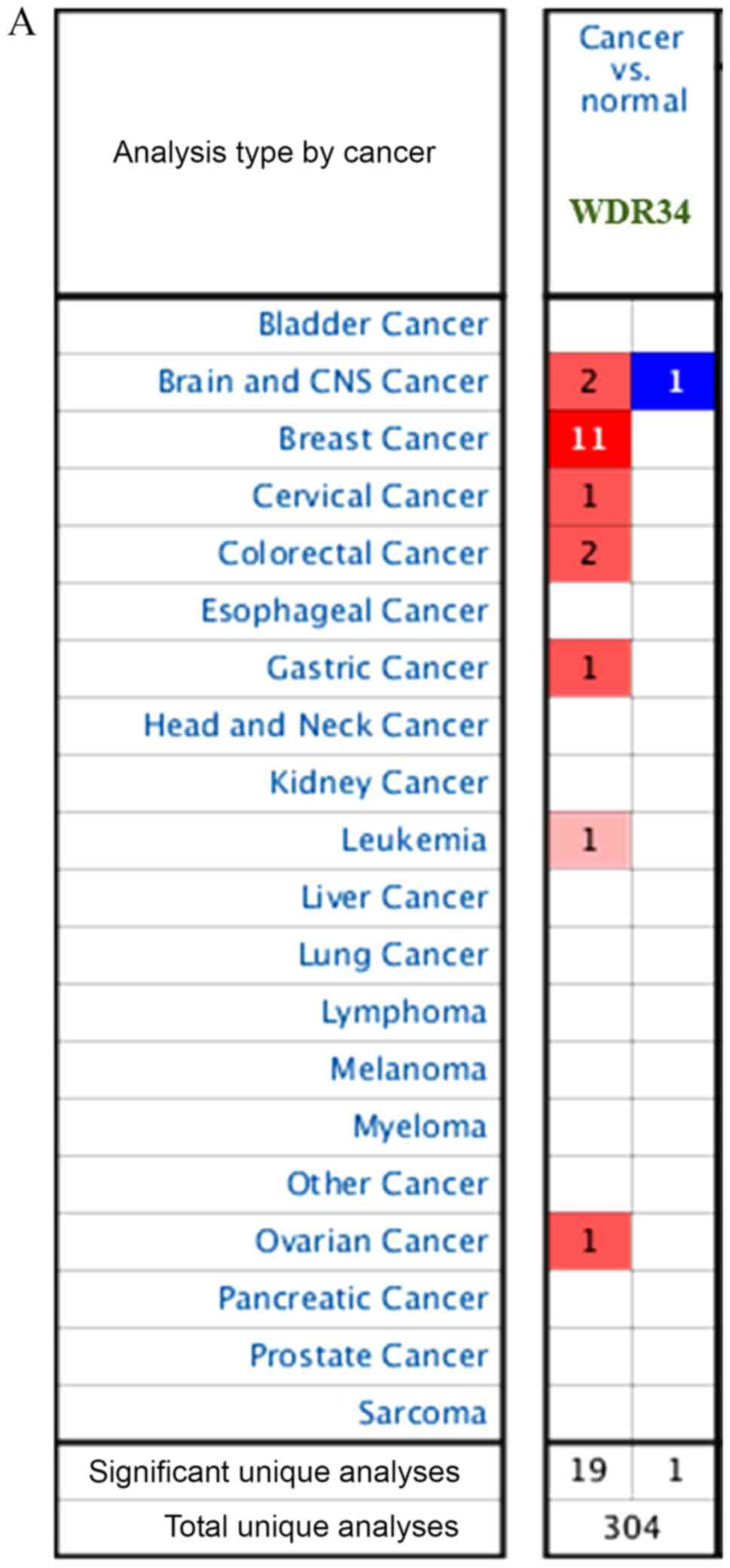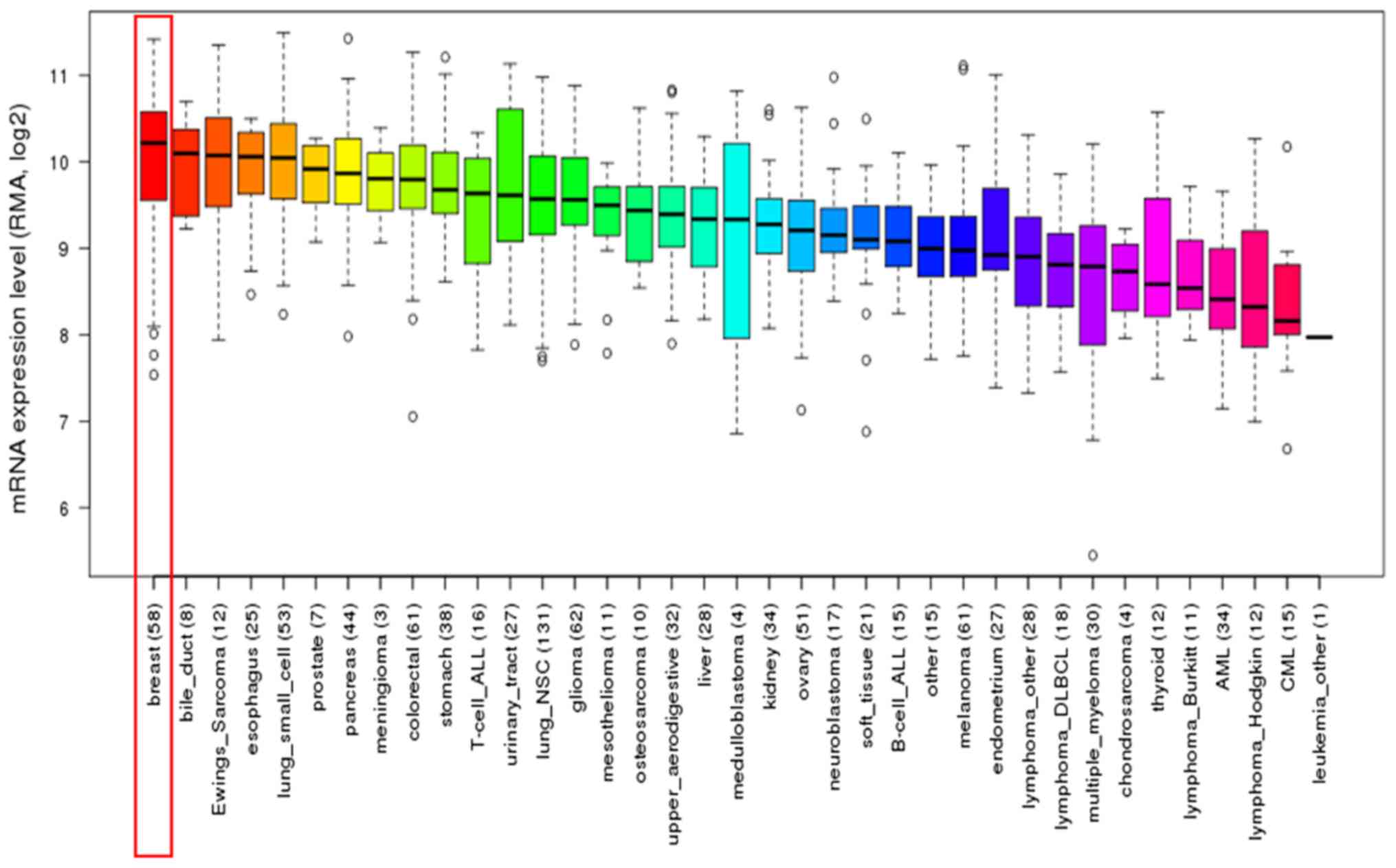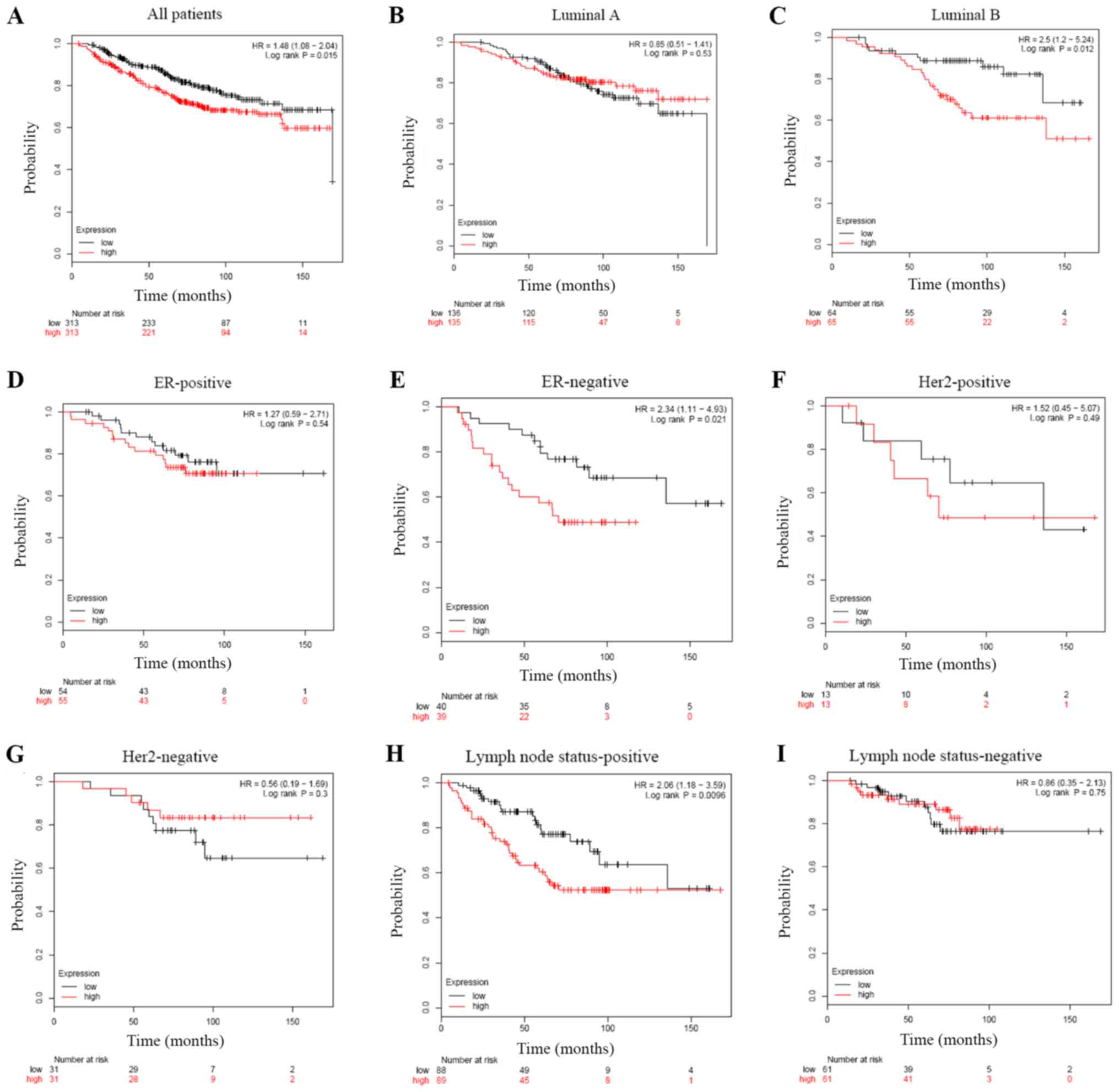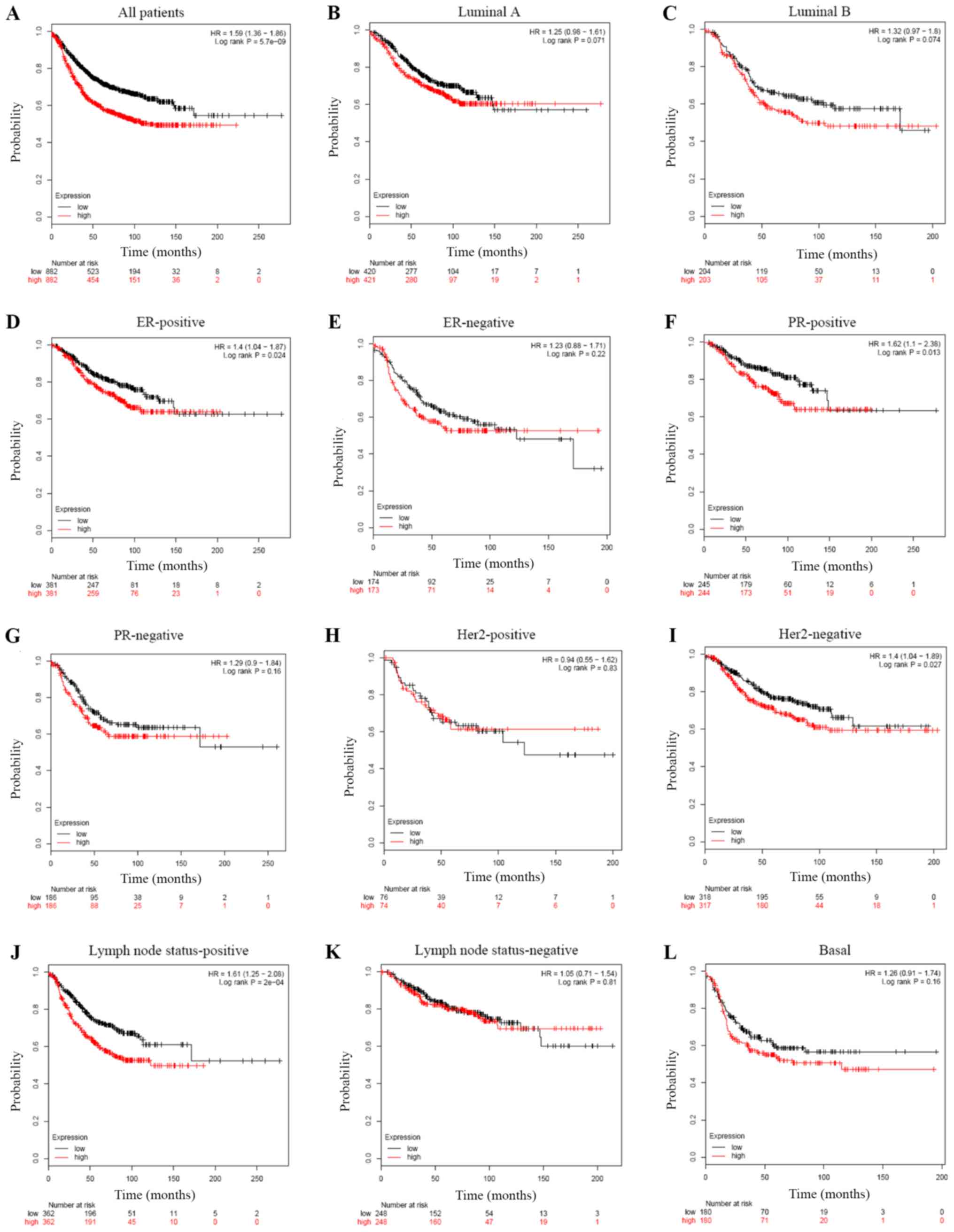|
1
|
Siegel RL, Miller KD and Jemal A: Cancer
statistics, 2018. CA Cancer J Clin. 68:7–30. 2018. View Article : Google Scholar : PubMed/NCBI
|
|
2
|
Kadalayil L, Khan S, Nevanlinna H,
Fasching PA, Couch FJ, Hopper JL, Liu J, Maishman T, Durcan L,
Gerty S, et al: Germline variation in ADAMTSL1 is associated with
prognosis following breast cancer treatment in young women. Nat
Commun. 8:16322017. View Article : Google Scholar : PubMed/NCBI
|
|
3
|
Si W, Shen J, Du C, Chen D, Gu X, Li C,
Yao M, Pan J, Cheng J, Jiang D, et al: A miR-20a/MAPK1/c-Myc
regulatory feedback loop regulates breast carcinogenesis and
chemoresistance. Cell Death Differ. 25:406–420. 2018. View Article : Google Scholar : PubMed/NCBI
|
|
4
|
Nicolini A, Ferrari P and Duffy MJ:
Prognostic and predictive biomarkers in breast cancer: Past,
present and future. Semin Cancer Biol. 52:56–73. 2018. View Article : Google Scholar : PubMed/NCBI
|
|
5
|
Smith TF: Diversity of WD-repeat proteins.
Subcell Biochem. 48:20–30. 2008. View Article : Google Scholar : PubMed/NCBI
|
|
6
|
van Nocker S and Ludwig P: The WD-repeat
protein superfamily in Arabidopsis: Conservation and divergence in
structure and function. BMC Genomics. 4:502003. View Article : Google Scholar : PubMed/NCBI
|
|
7
|
Gao D, Wang R, Li B, Yang Y, Zhai Z and
Chen DY: WDR34 is a novel TAK1-associated suppressor of the
IL-1R/TLR3/TLR4-induced NF-kappaB activation pathway. Cell Mol Life
Sci. 66:2573–2584. 2009. View Article : Google Scholar : PubMed/NCBI
|
|
8
|
Huber C, Wu S, Kim AS, Sigaudy S,
Sarukhanov A, Serre V, Baujat G, Le Quan Sang KH, Rimoin DL, Cohn
DH, et al: WDR34 mutations that cause short-rib polydactyly
syndrome type III/severe asphyxiating thoracic dysplasia reveal a
role for the NF-κB pathway in cilia. Am J Hum Genet. 93:926–931.
2013. View Article : Google Scholar : PubMed/NCBI
|
|
9
|
You SH, Lee YS, Lee CP, Lin CP, Lin CY,
Tsai CL, Chang YL, Cheng PJ, Wang TH and Chang SD: Identification
of a c.544C>T mutation in WDR34 as a deleterious recessive
allele of short rib-polydactyly syndrome. Taiwan J Obstet Gynecol.
56:857–862. 2017. View Article : Google Scholar : PubMed/NCBI
|
|
10
|
Wu C, Li J, Peterson A, Tao K and Wang B:
Loss of dynein-2 intermediate chain Wdr34 results in defects in
retrograde ciliary protein trafficking and Hedgehog signaling in
the mouse. Hum Mol Genet. 26:2386–2397. 2017. View Article : Google Scholar : PubMed/NCBI
|
|
11
|
Yamamoto JI, Kasamatsu A, Okubo Y,
Nakashima D, Fushimi K, Minakawa Y, Kasama H, Shiiba M, Tanzawa H
and Uzawa K: Evaluation of tryptophan-aspartic acid
repeat-containing protein 34 as a novel tumor-suppressor molecule
in human oral cancer. Biochem Biophys Res Commun. 495:2469–2474.
2018. View Article : Google Scholar : PubMed/NCBI
|
|
12
|
Mares J, Szakacsova M, Soukup V, Duskova
J, Horinek A and Babjuk M: Prediction of recurrence in low and
intermediate risk non-muscle invasive bladder cancer by real-time
quantitative PCR analysis: cDNA microarray results. Neoplasma.
60:295–301. 2013. View Article : Google Scholar : PubMed/NCBI
|
|
13
|
Jiang Y, Zhang L, Kong F, Zhang M, Lv H,
Liu G, Liao M, Feng R, Li J and Zhang R: MCPerm: A Monte Carlo
permutation method for accurately correcting the multiple testing
in a meta-analysis of genetic association studies. PLoS One.
9:e892122014. View Article : Google Scholar : PubMed/NCBI
|
|
14
|
Jézéquel P, Campone M, Gouraud W,
Guérin-Charbonnel C, Leux C, Ricolleau G and Campion L:
bc-GenExMiner: An easy-to-use online platform for gene prognostic
analyses in breast cancer. Breast Cancer Res Treat. 131:765–775.
2012. View Article : Google Scholar : PubMed/NCBI
|
|
15
|
Jézéquel P, Frénel JS, Campion L,
Guérin-Charbonnel C, Gouraud W, Ricolleau G and Campone M:
bc-GenExMiner 3.0: New mining module computes breast cancer gene
expression correlation analyses. Database (Oxford).
2013:bas0602013. View Article : Google Scholar : PubMed/NCBI
|
|
16
|
Lánczky A, Nagy Á, Bottai G, Munkácsy G,
Szabó A, Santarpia L and Győrffy B: miRpower: A web-tool to
validate survival-associated miRNAs utilizing expression data from
2178 breast cancer patients. Breast Cancer Res Treat. 160:439–446.
2016. View Article : Google Scholar : PubMed/NCBI
|
|
17
|
Gao J, Aksoy BA, Dogrusoz U, Dresdner G,
Gross B, Sumer SO, Sun Y, Jacobsen A, Sinha R, Larsson E, et al:
Integrative analysis of complex cancer genomics and clinical
profiles using the cBioPortal. Sci Signal. 6:pl12013. View Article : Google Scholar : PubMed/NCBI
|
|
18
|
Cerami E, Gao J, Dogrusoz U, Gross BE,
Sumer SO, Aksoy BA, Jacobsen A, Byrne CJ, Heuer ML, Larsson E, et
al: The cBio cancer genomics portal: An open platform for exploring
multidimensional cancer genomics data. Cancer Discov. 2:401–404.
2012. View Article : Google Scholar : PubMed/NCBI
|
|
19
|
Curtis C, Shah SP, Chin SF, Turashvili G,
Rueda OM, Dunning MJ, Speed D, Lynch AG, Samarajiwa S, Yuan Y, et
al: The genomic and transcriptomic architecture of 2,000 breast
tumours reveals novel subgroups. Nature. 486:346–352. 2012.
View Article : Google Scholar : PubMed/NCBI
|
|
20
|
Goda AA, Siddique AB, Mohyeldin M, Ayoub
NM and El Sayed KA: The maxi-K (BK) channel antagonist penitrem a
as a novel breast cancer-targeted therapeutic. Mar Drugs. 16(pii):
E1572018. View Article : Google Scholar : PubMed/NCBI
|
|
21
|
Goldhirsch A, Glick JH, Gelber RD, Coates
AS, Thurlimann B and Senn HJ; Panel members, : Meeting highlights:
International expert consensus on the primary therapy of early
breast cancer 2005. Ann Oncol. 16:1569–1583. 2005. View Article : Google Scholar : PubMed/NCBI
|
|
22
|
Sorlie T, Tibshirani R, Parker J, Hastie
T, Marron JS, Nobel A, Deng S, Johnsen H, Pesich R, Geisler S, et
al: Repeated observation of breast tumor subtypes in independent
gene expression data sets. Proc Natl Acad Sci USA. 100:8418–8423.
2003. View Article : Google Scholar : PubMed/NCBI
|
|
23
|
Perou CM, Sorlie T, Eisen MB, van de Rijn
M, Jeffrey SS, Rees CA, Pollack JR, Ross DT, Johnsen H, Akslen LA,
et al: Molecular portraits of human breast tumours. Nature.
406:747–752. 2000. View
Article : Google Scholar : PubMed/NCBI
|
|
24
|
Wang C, Sun X, Wang K, Wang Y, Yang F and
Wang H: Breast cancer targeted chemotherapy based on
doxorubicin-loaded bombesin peptide modified nanocarriers. Drug
Deliv. 23:2697–2702. 2016. View Article : Google Scholar : PubMed/NCBI
|
|
25
|
Mahaddalkar T and Lopus M: From natural
products to designer drugs: Development and molecular mechanisms
action of novel anti-microtubule breast cancer therapeutics. Curr
Top Med Chem. 17:2559–2568. 2017. View Article : Google Scholar : PubMed/NCBI
|
|
26
|
Li JJ and Xie D: RACK1, a versatile hub in
cancer. Oncogene. 34:1890–1898. 2015. View Article : Google Scholar : PubMed/NCBI
|
|
27
|
Giuliano AE, Connolly JL, Edge SB,
Mittendorf EA, Rugo HS, Solin LJ, Weaver DL, Winchester DJ and
Hortobagyi GN: Breast Cancer-Major changes in the American Joint
Committee on Cancer eighth edition cancer staging manual. CA Cancer
J Clin. 67:290–303. 2017. View Article : Google Scholar : PubMed/NCBI
|
|
28
|
O'Regan RM and Nahta R: Targeting forkhead
box M1 transcription factor in breast cancer. Biochem Pharmacol.
154:407–413. 2018. View Article : Google Scholar : PubMed/NCBI
|
|
29
|
Song X, Fiati Kenston SS, Zhao J, Yang D
and Gu Y: Roles of FoxM1 in cell regulation and breast cancer
targeting therapy. Med Oncol. 34:412017. View Article : Google Scholar : PubMed/NCBI
|
|
30
|
Lee JJ, Lee HJ, Son BH, Kim SB, Ahn JH,
Ahn SD, Cho EY and Gong G: Expression of FOXM1 and related proteins
in breast cancer molecular subtypes. Int J Exp Pathol. 97:170–177.
2016. View Article : Google Scholar : PubMed/NCBI
|
|
31
|
Nakachi I, Helfrich BA, Spillman MA,
Mickler EA, Olson CJ, Rice JL, Coldren CD, Heasley LE, Geraci MW
and Stearman RS: PTTG1 levels are predictive of saracatinib
sensitivity in ovarian cancer cell lines. Clin Transl Sci.
9:293–301. 2016. View Article : Google Scholar : PubMed/NCBI
|
|
32
|
Repo H, Gurvits N, Löyttyniemi E, Nykänen
M, Lintunen M, Karra H, Kurki S, Kuopio T, Talvinen K, Söderström M
and Kronqvist P: PTTG1-interacting protein (PTTG1IP/PBF) predicts
breast cancer survival. BMC Cancer. 17:7052017. View Article : Google Scholar : PubMed/NCBI
|
|
33
|
Yoon CH, Kim MJ, Lee H, Kim RK, Lim EJ,
Yoo KC, Lee GH, Cui YH, Oh YS, Gye MC, et al: PTTG1 oncogene
promotes tumor malignancy via epithelial to mesenchymal transition
and expansion of cancer stem cell population. J Biol Chem.
287:19516–19527. 2012. View Article : Google Scholar : PubMed/NCBI
|
|
34
|
Ren G, Tian Q, An Y, Feng B, Lu Y, Liang
J, Li K, Shang Y, Nie Y, Wang X and Fan D: Coronin 3 promotes
gastric cancer metastasis via the up-regulation of MMP-9 and
cathepsin K. Mol Cancer. 11:672012. View Article : Google Scholar : PubMed/NCBI
|
|
35
|
Iizaka M, Han HJ, Akashi H, Furukawa Y,
Nakajima Y, Sugano S, Ogawa M and Nakamura Y: Isolation and
chromosomal assignment of a novel human gene, CORO1C, homologous to
coronin-like actin-binding proteins. Cytogenet Cell Genet.
88:221–224. 2000. View Article : Google Scholar : PubMed/NCBI
|
|
36
|
Thal D, Xavier CP, Rosentreter A, Linder
S, Friedrichs B, Waha A, Pietsch T, Stumpf M, Noegel A and Clemen
C: Expression of coronin-3 (coronin-1C) in diffuse gliomas is
related to malignancy. J Pathol. 214:415–424. 2008. View Article : Google Scholar : PubMed/NCBI
|
|
37
|
Li M, Ouyang L, Zheng Z, Xiang D, Ti A, Li
L, Dan Y, Yu C and Li W: E3 ubiquitin ligase FBW7α inhibits
cholangiocarcinoma cell proliferation by downregulating c-Myc and
cyclin E. Oncol Rep. 37:1627–1636. 2017. View Article : Google Scholar : PubMed/NCBI
|
|
38
|
Wang J, Wang H, Peters M, Ding N, Ribback
S, Utpatel K, Cigliano A, Dombrowski F, Xu M, Chen X, et al: Loss
of Fbxw7 synergizes with activated AKT signaling to promote c-Myc
dependent cholangiocarcinogenesis. J Hepatol. pii:S0168–8278,
30342-30343. 2019.
|
|
39
|
Zhao D, Zheng HQ, Zhou Z and Chen C: The
Fbw7 tumor suppressor targets KLF5 for ubiquitin-mediated
degradation and suppresses breast cell proliferation. Cancer Res.
70:4728–4738. 2010. View Article : Google Scholar : PubMed/NCBI
|
|
40
|
Krishnamurti U and Silverman JF: HER2 in
breast cancer: A review and update. Adv Anat Pathol. 21:100–107.
2014. View Article : Google Scholar : PubMed/NCBI
|
|
41
|
Zhang K, Hong R, Kaping L, Xu F, Xia W,
Qin G, Zheng Q, Lu Q, Zhai Q, Shi Y, et al: CDK4/6 inhibitor
palbociclib enhances the effect of pyrotinib in HER2-positive
breast cancer. Cancer Lett. 447:130–140. 2019. View Article : Google Scholar : PubMed/NCBI
|
|
42
|
Ahmed S, Sami A and Xiang J: HER2-directed
therapy: Current treatment options for HER2-positive breast cancer.
Breast Cancer. 22:101–116. 2015. View Article : Google Scholar : PubMed/NCBI
|
|
43
|
Mercogliano MF, De Martino M, Venturutti
L, Rivas MA, Proietti CJ, Inurrigarro G, Frahm I, Allemand DH, Deza
EG, Ares S, et al: TNFα-induced mucin 4 expression elicits
trastuzumab resistance in HER2-positive breast cancer. Clin Cancer
Res. 23:636–648. 2017. View Article : Google Scholar : PubMed/NCBI
|
|
44
|
Hearne BJ, Teare MD, Butt M and Donaldson
L: Comparison of Nottingham Prognostic Index and Adjuvant Online
prognostic tools in young women with breast cancer: Review of a
single-institution experience. BMJ Open. 5:e0055762015. View Article : Google Scholar : PubMed/NCBI
|
|
45
|
Albergaria A, Ricardo S, Milanezi F,
Carneiro V, Amendoeira I, Vieira D, Cameselle-Teijeiro J and
Schmitt F: Nottingham Prognostic Index in triple-negative breast
cancer: A reliable prognostic tool? BMC Cancer. 11:2992011.
View Article : Google Scholar : PubMed/NCBI
|
|
46
|
Kabbage M, Trimeche M, Ben Nasr H, Hammann
P, Kuhn L, Hamrita B and Chahed K: Tropomyosin-4 correlates with
higher SBR grades and tubular differentiation in infiltrating
ductal breast carcinomas: An immunohistochemical and
proteomics-based study. Tumour Biol. 34:3593–3602. 2013. View Article : Google Scholar : PubMed/NCBI
|
|
47
|
Song R, Wang ZD and Schapira M: Disease
association and druggability of WD40 repeat proteins. J Proteome
Res. 16:3766–3773. 2017. View Article : Google Scholar : PubMed/NCBI
|
|
48
|
Yuan Y, Qi G, Shen H, Guo A, Cao F, Zhu Y,
Xiao C, Chang W and Zheng S: Clinical significance and biological
function of WD repeat domain 54 as an oncogene in colorectal
cancer. Int J Cancer. 144:1584–1595. 2019.PubMed/NCBI
|
















